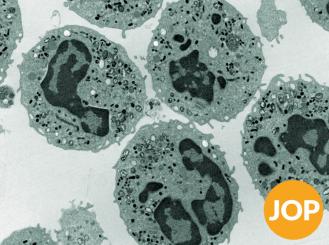Sep 30, 2015
By Shira Klapper, Senior Writer/Editor
A research team out of Cleveland Clinic carried out an intervention that significantly reduced the time between when patients with febrile neutropenia presented to the emergency department and when those patients received antibiotics. The study, “Reducing Time to Antibiotic Administration for Febrile Neutropenia in the Emergency Department,” was published in the Journal of Oncology Practice (JOP), online, ahead of print, July 28.
Febrile neutropenia, which is fever in the setting an abnormally low white blood cell, is a common side effect for patients receiving chemotherapy and substantially compromises the immune system. For patients with this condition, time to antibiotic administration (TTA) is crucial: studies have shown that a shorter time to TTA improves survival and reduces the patients’ hospital length of stay (LOS). ASCO guidelines issued in 2013 recommend that patients with FN receive antibiotics within one hour of arriving at the ER.
For the 223 patients treated as part of the “febrile neutropenia pathway” (FNP)—the intervention that established a process for treating patients presenting to the ER with FN—the median wait time to TTA was 81 minutes, compared with 235 minutes among patients whose data was gathered from historical records and 169 minutes among patients admitted to the ER who were not on the protocol. In addition, among patients treated on the FNP intervention, 57% received antibiotics within 90 minutes of arriving at the ER; for patients whose data was gathered from the historical records and patients not on the protocol, only one and 13%, respectively, were seen within 90 minutes. In addition to having a shorter wait time to TTA, patients in the intervention group had a significantly shorter LOS—3.3 days, compared with 4.3 days among patients not treated on the protocol.
Commenting on the study’s findings, study coauthor Mikkael A. Sekeres, MD, MS, said, “In my opinion, these results are a huge deal because it’s often so challenging to demonstrate that a quality intervention, such as reducing TTA, also translates into value, such as shorter hospital stays. But our study was actually able to accomplish both of these things.”
A need for a shorter wait time for patients with febrile neutropenia
The researchers devised the study based on findings showing that patients with cancer who present to ERs with febrile neutropenia often experience delays in TTA due to several factors, including ER crowding and being triaged at a lower level than other patients. In addition, Dr. Sekeres said the study was a response to patient experiences he observed first hand.
“I personally heard from patients whom I referred to the emergency room in the setting of a fever when their immune system was compromised who said, ‘you know, I had to sit for hours in this waiting room and I had to sit next to people who were coughing and I was wondering whether I was even getting sicker sitting there.’ I wanted to listen to what my patients were telling me.”
Creating a protocol to reduce wait time for antibiotics
With the goal of reducing TTA, the researchers devised a “febrile neutropenia pathway” (FNP), to address the causes of major delays in the ER.
“We gathered together colleagues from the ER, including infectious disease colleagues, pharmacists, nurses, doctors, and programmers,” said Dr. Sekeres. “We got everybody in a room and said, ‘here’s this problem we want to fix. And over a series of meetings, we got to understand everyone’s view about the patient process.”
Based on these meetings, the researchers devised an FNP that included eight guidelines aimed at shortening the time between when patients presented with FN to when they received antibiotics. First, FN was reclassified as being on the same level as cerebral-vascular accident or myocardial infarction; second, FN patients were triaged to private rooms at registration, instead of waiting rooms; three, the definition of FN was standardized across hospital sites; four, each patient carried an FN-Alert card with specific instructions, to be presented at the RD triage; five, standardized order set were created in the EMR; six, antibiotics were administered before completing the blood count that confirmed neutropenia; seven, FNP antibiotics were made readily available to avoid delays from the pharmacy; and eight, staff received education about the FNP.
According to Dr. Sekeres, one of the important aspects of this study is that it can be carried out in any cancer center.
“This is a very simple intervention that doesn’t need to be at Cleveland clinic. It can be carried out at any hospital around the country and has the potential to accelerate the time from when a patient presents to the ER to when that patient receives antibiotic.”
Mikkael Sekeres, MD, MS, is Director of the leukemia program at the Cleveland Clinic. He is a frequent contributor to the New York Times “Well” blog.
Abstract of the original JOP article.
PDF of the original JOP article.
Keng MK, Thallner EA, Elson P, et al. Reducing time to antibiotic administration for febrile neutropenia in the emergency department. J Oncol Pract. Epub 2015 July 28.
The Exclusive Coverage series on ASCO.org highlights selected research from JCO and JOP with additional perspective provided by the lead or corresponding author.
@ 2014 American Society of Clinical Oncology


